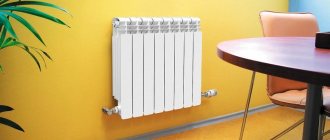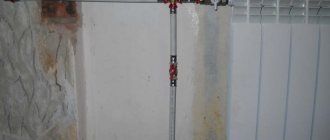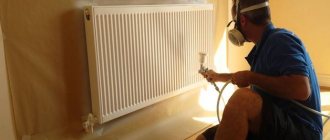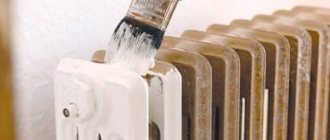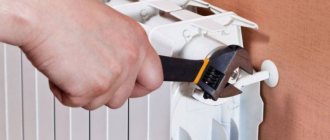It would seem that the utility workers are sparing neither effort nor fuel - they won’t touch the radiator. And at the same time, even in a warm robe, it’s uncomfortable in the house.
Olga Nesmelova · February 8, 2019
“Maybe the heating is bad?” - the hand itself reaches for the battery - check. We get burned, we pull back: no, they heat well, you can’t complain about it. But why then is it so cold?
You can find “pockets of frost” using thermal imaging. But it can be simpler. Exactly how, Vadim Vozny ,
Reason 1: Not enough radiator sections
If the batteries are working at full capacity, but the air has not warmed up, it is worth checking several points that may affect the overall temperature in the house.
First of all, make sure that the number of radiator sections is sufficient for full heating. Here, a lot depends on the area of the room and the material from which the battery is made. For an approximate calculation, you can use the values that are determined based on the average SNiP standards.
“One section of a bimetallic radiator will heat 1.8 square meters of area, aluminum - 1.9-2 square meters, and cast iron - 1.4-1.5 square meters. It remains to divide the total area of the room by one of these coefficients. For example, to heat a 16-meter room, you will need an aluminum radiator with 8 sections,” says the OBI expert.
It is also worth remembering that according to the operating rules, the distance from the window sill and floor to the radiator should be at least 10 cm, and from the wall on which it is installed, at least 3 cm. Furniture should be located no closer than 6 cm from the heating device. If you do not follow these rules, the heat transfer from the batteries is significantly reduced.
And, by the way, the refrigerator should also be kept away from the radiator.
Why does the battery have a cold bottom - due to the low speed of the coolant
If the liquid medium moves slowly, then when it reaches the return from below, it has time to cool down. If its speed is normal, the battery will be warm in all places.
The average speed of fluid movement through the heating system in private houses and apartments is 0.5-1.5 m/s.
The intensity of circulation is influenced by several factors:
- pumping equipment power,
- state and cross-section of communications,
- battery material,
- coolant characteristics.
If the circular pump has low power or has stopped working, the flow rate of the working medium will be reduced.
In addition, there are gravity-type heating schemes. They work without a pump, so they do not always provide stable performance.
The diameter of the pipes can be narrowed for several reasons:
- poor-quality soldering of plastic,
- small cross-section control valve,
- accumulation of sediments in the old pipeline.
Any heating system contains foreign impurities. They circulate along with water, settling in various places in the battery. In cast iron communications this happens faster than in polypropylene ones.
Heating radiator with ball valve
When the amount of deposits reaches a critical level, it begins to impede the flow of coolant. As a result, the battery remains hot on top and cold on the bottom.
Reason 2. Blockage in the battery
Corrosion, deposits deposited on the internal walls - because of them, the radiator can become clogged. If water is taken from a well as a coolant without preliminary purification, the radiator quickly becomes unusable, regardless of the quality of manufacture.
“If the batteries are clogged, it is better to replace them with modern models that are more resistant to corrosion. For example, on a bimetallic radiator, such batteries ensure 100% passability and uninterrupted operation even with the most polluted central heating systems,” advises the OBI expert.
Battery installation and connection
Illiterate installation leads not only to uneven heating, but also to a pipe break and flooding of the room. In addition, if the radiator is assembled incorrectly, in the event of a breakdown, repairs under warranty can be out of the question. Therefore, trust the work only to professionals.
The bypass valve is not installed correctly
The most common mistake. Bypass is a bypass channel in the piping. It is placed in front of the battery entrance. One end is connected to the inlet pipe, and the other to the outlet pipe.
In single-pipe circuits, the presence of the device is mandatory. With its help, they regulate the flow of coolant and perform repair and maintenance work without disconnecting from the central heating.
Shut-off valves - ball valves - are installed between the bypass and the openings (inlet and outlet). When choosing components, take into account possible water hammer.
Incorrect pipe diameter
The diameter of the vertical bypass should not exceed the cross-section of the main pipe. When executed horizontally, it is equal to it. When installed in a private house, the bypass diameter should be one size smaller than the central line.
If the diameter of the pipes is smaller than the diameter of the circuit, then heating of the battery will stop.
Why is the battery cold on the bottom and hot on the top? It’s due to low pressure in the circuit
Due to the design features, the problem occurs more often in new models. Unlike cast iron, modern versions of batteries are distinguished by narrowed passages. Therefore, for stable movement of liquid, a certain pressure is required.
The following reasons lead to a decrease in pressure:
- increasing the number of sections (including in neighboring apartments),
- warm floor,
- faults in the line.
Due to the reduced pressure, the battery becomes cold at the bottom and remains hot at the top. Why is this happening:
- air pockets form,
- The coolant cools down quickly,
- the balance is disrupted.
In addition, if the line is designed for cast iron, it may not be able to handle the pressure required for systems made of other materials.
Reason 3. Heat goes outside
Another way to increase the heat output of a radiator is to install a thermal reflector or aluminum foil screen behind it, which will direct the thermal energy into the room and not onto the wall of the house. You will be able to receive 15 percent more heat from the battery, which is used to warm up the wall that is not insulated from the outside, releasing useful heat to the street. If your radiators have been repainted several times during their service, then remove all the old paint from them and repaint them in one layer. Remember: each new layer reduces heat transfer by 10 percent.
Oksana Shavyrina • 01/13/2016
With the arrival of winter, many residents of both private and apartment buildings begin to freeze. Someone complains that he has a corner apartment, and someone scolds careless developers. Either way, you need to do something to stay comfortable in your own home during the long cold months.
Summary
The steps suggested above are a basic package of activities. You may have already done some of them. Or maybe you are just about to conduct an energy audit; by the way, it always makes sense to start with this.
The research results will tell you which direction to start moving in and will save you from unnecessary costs. When organizing thermal insulation of a house, an integrated approach is desirable; if you insulate the facade, then do it over the entire area, and not apartment by apartment.
Many of the typical mistakes in home insulation are easily eliminated. After which the energy efficiency of the building improves. As for the apartment, here, for example, it is easy to eliminate the flow of cold air through the installation ducts of the air conditioner, cracks in windows and doors. You will immediately notice that the room immediately becomes warmer.
Causes of cold indoors
Low indoor air temperatures are a consequence of failure to maintain the required heat balance. That is, in fact, the heat that goes outside exceeds the permissible heat that is comfortable for staying in a living room. As a result, the thermal energy in the room is reduced. Why is it cold at home? There may be several reasons for this phenomenon:
- Direct heat exchange . The inside of the room is heated, but outside it is cold. Due to this temperature difference, heat penetrates through the walls, ceilings and floors, leaving the home.
- Drafts, air currents . If there are openings in the house, cold air can enter through them and heated air can come out. A draft occurs due to the difference in pressure on the sides of the house created by the blowing wind. In addition, a vertical draft can be observed in the house, caused by flows of warm air rising upward and cold air flowing from below through the floor.
- Radiation . It's very cold at home because the infrared radiation in the house creates heat that penetrates the walls and goes outside.
Insufficient temperature of the device
The term “hot batteries” is relative. In some cases, it is necessary to raise the temperature of the radiator, ensuring faster heating of the air in the room and getting rid of the cold. As a rule, in apartment conditions with a centralized heating system, the first step to correct this situation is to file a standard claim application with the dispatch service of the management company (MC). It is important to remember that there are certain standards that do not always coincide with the personal preferences of residents:
- kitchen – 18oC;
- bathroom – 25°C;
- living rooms – 18°C;
- corner rooms – 20°C.
Arriving representatives of utility services are required to carry out official temperature measurements. If the validity of the residents’ claims is established, the management company will take measures aimed at normalizing heating in the apartment. If the complaint is unsuccessful, you will have to increase the temperature in alternative ways by purchasing special heating devices.
Keeping the apartment warm
You need to think about keeping your room warm in the winter in the summer. Anyone who has already experienced one cold winter will take measures to prevent a similar situation in the future. What you can do before the cold weather sets in:
- peel off all the old paint from the batteries, since each new layer reduces heat transfer by 10%. After all these measures, the radiators can be extended and covered with a layer of new paint, preferably dark in color;
- install a screen of aluminum foil behind the radiators, which will prevent unnecessary heating of the wall and allow the thermal energy to be directed into the room. It is very important not to let it remain unclaimed, which means with the arrival of winter it is necessary to free up space near the radiator by moving furniture and other household items, opening heavy curtains and putting tulle on the windowsill;
- replace old windows with new ones and it is better if they are equipped with 3 glasses and a climate control system;
- cover the balcony or loggia, insulating it.
Measures to keep warm with the arrival of winter:
- if the radiators are hot and the house is cold, it is necessary to exclude the presence of drafts. You should walk with a candle along all the walls and, where its flame will be restless, insulate the surface;
- Pay special attention to the tightness of window openings. Today on sale you can find a variety of sealants and insulation materials that will solve this problem;
- install fans above the radiators.
Where to go if the radiators are a little warm, but there is no trust in local housing and communal services representatives
After submitting a claim, you can wait a week, unless cold weather and life circumstances (for example, the presence of small children or weak health members in the family) force you to act earlier.
If there is no proper response, such a complaint should be sent to a higher authority - the district housing inspection or Rospotrebnadzor. To the document it is necessary to add information about the actions taken previously, a copy of the first statement, reporting the lack of an appropriate response from the FSW.
In case of repeated silence, the next authority will be the prosecutor's office. The submitted complaint must be accompanied by documentary evidence of the futility of previous attempts to resolve the issue and provide information about the harm caused by the inaction of officials to residents of the apartment.
You can also go to court, but cases are not considered quickly and it is better to go there after resolving the main part of the issue, presenting a claim for compensation for material and moral damage.
Citizens faced with such difficulties often express the opinion that it is useless to contact the local housing and communal services, advising them to act immediately through higher-level authorities or send the original complaint to the management company, and at the same time copies to all other regulatory organizations.
Each case is individual, and it is impossible to make unambiguous prejudicial judgments about all organizations of this kind. The scale and intensity of action taken depends on many factors. How persistently and where to complain about cold batteries, what to do in a particular case - everyone decides for themselves.
Keeping warm in a private home
How to keep the house warm? Even when building a house, it is necessary to provide high-quality insulation and air insulation with materials suitable for the main building material from which the house is made. Those who moved into a ready-made house and discovered that it was cold in winter will have to solve the problem on the spot. What can you do in this case:
- insulate the foundation. To prevent it from freezing, they lay sheets of foam plastic, cover them with insulating material, cover them with earth and seal the blind area with concrete;
- lay mineral wool, glass wool, polystyrene foam or liquid penoizol on the ceiling. Having climbed into the attic, pour a layer of expanded clay, dry sand or sawdust onto the floor. If the cladding of the upper floor is weak, it is dismantled, and foam plastic or mineral wool is placed in the spaces between the beams;
- if the floor at home is cold, it is insulated with slabs, OSB boards, and boards. You can lay insulation in the openings between the joists, and only then proceed to the final finishing of the floor;
- walls can be covered with heat-insulating boards, for example, penoplex;
- install a second door or insulate an existing one;
- seal the joints between the panels outside the house.
Connection errors
Another reason why batteries may remain cold is incorrect connection of heating system elements. The biggest mistake is connecting radiators to pipes, in which water is supplied from below. In this case, the sections are heated unevenly, and part of it remains cold. This is most often typical for side connections. What should I do to ensure that the surface of the radiators heats up evenly and the apartment becomes warm? To do this, you need to correctly connect them to the system.
USEFUL INFORMATION: How to install a tap on a radiator
Too many sections can also contribute to uneven heating, since coolant circulation is difficult. A special extension cord connected to the pipe that supplies hot water to the battery will help improve it.
Expert opinion
Anton Tsugunov
Construction expert. Entrepreneur. 17 years of experience. More than 100 completed objects.
Advice! For uniform heating of radiators, the best option is a diagonal connection, which ensures maximum efficiency of the heating system.
How should a recorded violation affect payment for the service?
If the radiators are barely warm, where should you go to avoid paying for almost no heating?
If there is a confirmed violation of the heat supply norm, the companies providing this service are obliged to recalculate the fee for it downwards.
To do this, you should send an application to the organization, attaching a copy of the report with the results of temperature measurements taken in the room.
It is lawful to refuse compensation for costs for unprovided services only in the event of force majeure reasons for violation of the terms of the contract (natural disasters).
Heat transfer by air jet
Air transfers heat due to pressure differences.
Cold air will penetrate into the unsealed seam around the perimeter of the window frame, so the house will be cold.
Those layers of insulation that are installed without a continuous enclosing structure (on the roof) must be protected by a special membrane or waterproofing. The purpose of such protection is to prevent the transfer of heat by air.
Unfortunately, hidden heat leaks are becoming more and more common in modern country houses and cottages. Next, let's look at their most common examples.
Which areas need to be insulated?
To reduce heat transfer from object to object, you need to put insulation on a warm object, as a result of which heat will leave it at a slower rate. Now the heat loss of the object will be directly affected by the thickness of the insulation and its heat resistance.
You can reduce the direct path of heat transfer if you place insulation in the following areas:
- house walls;
- floors;
- roof or ceiling;
- external and internal side surfaces of the foundation.
It is important! It is not practical to insulate the internal foundation if it is not insulated from the outside, because... this may cause it to freeze.
By the way, material on the topic:
Why does the roof freeze and how to deal with it?
Why do walls freeze and how to deal with it?
Waterproofing a country house
Effective moisture protection is also necessary for every home. It includes a membrane of roofing felt, waterproofing or bicroelast between the frame wall and the plinth. If the base is thick relative to the wall, it is necessary to drain it to remove moisture. To avoid dampening of the insulation in the walls, it is necessary to provide an air layer for it with a thickness of at least 50 centimeters.
Remember that wet insulation loses its properties and is destroyed.
To protect the insulation from blowing, windproof material is used on the surface of the insulation located on the side of the air gap. And also “vents” are made in the upper and lower sections of the walls so that the air gap is ventilated.
How to enlarge an aluminum radiator?
Such radiators are considered the warmest. It is thanks to the good thermal conductivity coefficient of aluminum that even a small device has high thermal power. Manufacturers of aluminum batteries have begun to use specialized anti-corrosion coatings, which allows for maximum use in a variety of heat supply systems.
Algorithm for increasing aluminum sections
It is quite easy to grow such batteries. The man in the house is capable of doing this kind of work on his own. In this matter, it is only important not to confuse the threads on the nipple.
Procedure for extending aluminum sections:
- The radiator is being dismantled.
- A nipple with a sealing gasket is inserted into both structures.
- Screw in the nipple alternately, a couple of turns at the top/bottom until they connect.
- Perform final tightening of the nipple, being careful not to damage the thread.
Preventing heating problems
Preventative work should be performed in the summer. It is better to combine them with major or current repairs. For the heating system to work properly, you need to:
- analyze the heating operation in the previous winter, find weak points;
- check the operation of shut-off valves, repair or replace faulty ones;
- if Mayevsky taps or valves for supplying coolant to heating devices are missing, they should be installed;
- check the slopes of the supply pipes, eliminate violations, if this is not possible, install Mayevsky taps in problem areas;
- flush or replace radiators that did not heat up enough during the previous heating season.
Prepare your heating system for operation in the summer and the likelihood of failures will be greatly reduced.
Heat leakage with infrared radiation
Infrared waves are emitted by any object whose temperature exceeds absolute zero. Moreover, the higher its temperature, the more infrared rays it emits.
Walls (if they are warm), ceiling, doors, etc. – all this releases radiant energy into space (and into the bargain, the owner’s money!)
The largest amount of such energy leaves the house through transparent glass windows. The metalized glass coating reflects most of the IR heat back into the house.
Experts have calculated that the use of such glass saves about 1 ton of solid fuel per season, especially in northern latitudes.
Heat leaks with air convection
Warm air rushes upward, where it meets an object and transfers its heat to it; after cooling, it falls down, i.e. convection movement of air with heat transfer occurs. This is how air circulates in the house from the heating radiator to the ceiling and in the reverse order.
But such convection can be either natural, as described above, or pathological.
A striking example of pathological convection is the movement of air in a layer of insulation with large gaps between the fibers. For example, in a layer of loose mineral wool, etc.
The air moves from the edge of the insulation to its center, where it heats up and rushes upward, leaving the material and taking its heat. Thus, this layer loses its thermal insulation properties.
To prevent this phenomenon, you need to cover the insulation with a thick layer, for example, paper and sprinkle with sand. In this case, steam will still move.
The radiators are hot, but the house is still cold: what to do
Heating radiators are not always the cause of cold in an apartment. They can be fiery and the room temperature is low. What to do if it’s cold in your apartment not because the batteries are turned off.
First of all, it is important to establish the cause of such a situation and begin to eliminate it.
The first thing you should pay attention to is the quality of the window frames.
Old wooden frames have long outlived their usefulness and require replacement. An excellent solution would be to install modern plastic double-glazed windows. If they are already installed, then you need to call a technician to check and possibly identify the cause of cold air leakage. You can insulate old windows using cotton wool, tape or foam rubber. More reliable materials include silicone sealant, putty and rubber gaskets.
It is worth paying attention to the walls: due to violations of technology during the construction of the house, they may freeze or crack. In this case, they require internal and external insulation with special materials: mineral wool, polystyrene foam boards, cellulose, foil and liquid insulation, polyurethane foam, penoplex. Insulation of the outer part of the wall should only be carried out by specialists. In this case, it is recommended to sheathe the facade of the balcony, which very often causes the penetration of cold air.
If the source of cold is the floor, it is necessary to improve it. Today, the heated system is especially popular.
In addition, it is worth checking the tightness of the front door: you can replace the trim and eliminate cracks and holes that allow cold air to pass through.
What are the types of heat loss?
Let’s conditionally divide them into 2 types:
1. Natural – these are significant heat losses through the windows, roof and walls of the house. Even if your house is built perfectly, its roof and walls are sufficiently insulated, it will still lose some heat. It will not be possible to avoid such losses, but minimizing them is quite possible. How? Read on!
2. “Heat leaks” are heat losses that can be detected and completely eliminated. These heat losses can be identified independently, but only in those cases when the cracks actually begin to “siphon.” Of course, in modern country houses and cottages this happens extremely rarely. Most often, it is impossible to visually detect such leaks.
Any heated house can be compared to a chimney, when warm air comes out of it, and cold air tends to penetrate into the room. Due to the difference in pressure inside and outside the house, the same thing happens. Moreover, the “chimney” phenomenon occurs not only when windows or doors are open, but also when there are small cracks and cracks in the building that are invisible to the eye.
To clearly understand how heat leaves the house, let's first understand how heat transfer in space can occur. After all, in order for your home to become truly warm, you need to reliably block all escape routes for warm air.
So, let's look further at how exactly heat is lost.
